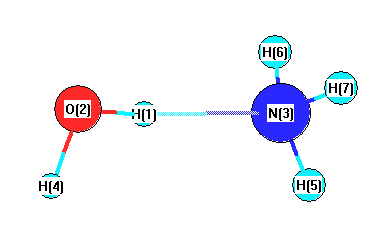Vibrational Frequencies calculated at CCSD(T)/3-21G
| Mode Number |
Symmetry |
Frequency
(cm-1) |
Scaled Frequency
(cm-1) |
IR Intensities
(km mol-1) |
Raman Act
(Å4/u) |
Dep P |
Dep U |
|---|
| 1 |
A' |
3497 |
3464 |
|
|
|
|
| 2 |
A' |
3487 |
3454 |
|
|
|
|
| 3 |
A' |
3350 |
3319 |
|
|
|
|
| 4 |
A' |
3286 |
3255 |
|
|
|
|
| 5 |
A' |
1799 |
1782 |
|
|
|
|
| 6 |
A' |
1772 |
1756 |
|
|
|
|
| 7 |
A' |
1084 |
1074 |
|
|
|
|
| 8 |
A' |
522 |
517 |
|
|
|
|
| 9 |
A' |
237 |
234 |
|
|
|
|
| 10 |
A' |
217 |
215 |
|
|
|
|
| 11 |
A" |
3488 |
3455 |
|
|
|
|
| 12 |
A" |
1768 |
1752 |
|
|
|
|
| 13 |
A" |
835 |
828 |
|
|
|
|
| 14 |
A" |
202 |
200 |
|
|
|
|
| 15 |
A" |
33 |
32 |
|
|
|
|
Unscaled Zero Point Vibrational Energy (zpe) 12788.5 cm
-1
Scaled (by 0.9906) Zero Point Vibrational Energy (zpe) 12668.3 cm
-1
See section
III.C.1 List or set vibrational scaling factors
to change the scale factors used here.
See section
III.C.2
Calculate a vibrational scaling factor for a given set of molecules
to determine the least squares best scaling factor.
Charges, Dipole, Quadrupole and Polarizability
Charges from optimized geometry at CCSD(T)/3-21G
Charges (e)
| Number |
Element |
Mulliken |
CHELPG |
AIM |
ESP |
| 1 |
H |
0.403 |
|
|
|
| 2 |
O |
-0.789 |
|
|
|
| 3 |
N |
-0.866 |
|
|
|
| 4 |
H |
0.323 |
|
|
|
| 5 |
H |
0.305 |
|
|
|
| 6 |
H |
0.312 |
|
|
|
| 7 |
H |
0.312 |
|
|
|
Electric dipole moments
Electric dipole components in Debye
(What's a Debye? See section
VII.A.3)
| |
x |
y |
z |
Total |
| |
1.489 |
-4.523 |
0.000 |
4.762 |
| CHELPG |
|
|
|
|
| AIM |
|
|
|
|
| ESP |
|
|
|
|
Electric Quadrupole moment
Quadrupole components in D Å
Polarizabilities
Components of the polarizability tensor.
Units are
Å
3 (Angstrom cubed)
Change units.
| |
x |
y |
z |
| x |
0.000 |
0.000 |
0.000 |
| y |
0.000 |
0.000 |
0.000 |
| z |
0.000 |
0.000 |
0.000 |
<r2> (average value of r
2) Å
2
| <r2> |
55.933 |
| (<r2>)1/2 |
7.479 |
